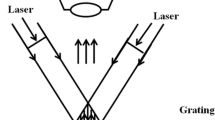Abstract
The full-field technique of high-sensitivity moiré interferometry in conjunction with a multiple-hole-drilling procedure is applied to residual-stress measurements in the presence of gradients. The method arrives at residual-stress estimates starting from in-plane displacement components. Successful applications of the method to problems simulating the nonuniform transverse residual stresses of welded joints are reported.
Similar content being viewed by others
References
Masubuchi, K., Analysis of Welded Structures Chapt. 4, Pergamon Press, 112–147 (1980).
Anon., “Standard Method for Determining Residual Stresses by the Hole-Drilling Strain-Gage Method,” ASTM Standard E837-81, Amer. Soc. for Test. and Mat., Philadelphia (1981).
Antonov, A.A., “Inspecting the Level of Residual Stresses in Welded Joints by Laser Interferometry,” Welding Production, 29–31 (Sept. 1983).
Nelson, D.V. andMcCrickerd, J.T., “Residual-stress Determination Through Combined Use of Holographic Interferometry and Blind-hole Drilling,”Experimental Mechanics,26 (4),371–378 (1986).
McDonach, A., McKelvie, J., MacKenzie, P. and Walker, C.A., “Improved Moiré Interferometry and Applications in Fracture Mechanics, Residual Stress and Damaged Composites,” Experimental Techniques, 20–24 (1983).
Nicoletto, G., “A Moiré-interferometric Hole-drilling, Method for Residual Stress Measurements,” Application of Advanced, Strain Measurement Techniques, BSSM, 1–12 (1988).
Post, D., “Moiré Interferometry,” Handbook of Experimental Mechanics, ed. A.S. Kobayashi, Chapt. 7, Prentice-Hall, 314–387 (1987).
Nicoletto, G., “Theoretical Fringe Analysis for a Coherent Optics Method of Residual Stress Determination,”J. Strain Analysis for Eng.,23,169–178 (1988).
Schaier, G.S., “Application of Finite Element Calculations to Residual Stress Measurements, “J. Eng. Mat. and Tech.,103,157–163 (1981).
Flaman, M.T. andManning, B.H., “Determination of Residual Stress Variation with Depth by the Hole-drilling Method,”Experimental Mechanics,25,205–220 (1985).
Cordiano, H.V. andSalerno, V.L., “Study of Residual Stresses in Linearly Varying Biaxial-stress Fields,”Experimental Mechanics,9 (1),17–24 (1969).
Chakrabarty, J., Theory of Plasticity, McGraw-Hill, 126–129 (1987).
Nicoletto, G., “Non-uniform Residual Stress Determination by a Laser Method,” Proc. 2nd Int. Conf. on Residual Stresses-ICRS2, Elsevier, 110–115 (1989).
Author information
Authors and Affiliations
Rights and permissions
About this article
Cite this article
Nicoletto, G. Moiré interferometry determination of residual stresses in the presence of gradients. Experimental Mechanics 31, 252–256 (1991). https://doi.org/10.1007/BF02326068
Received:
Revised:
Issue Date:
DOI: https://doi.org/10.1007/BF02326068




